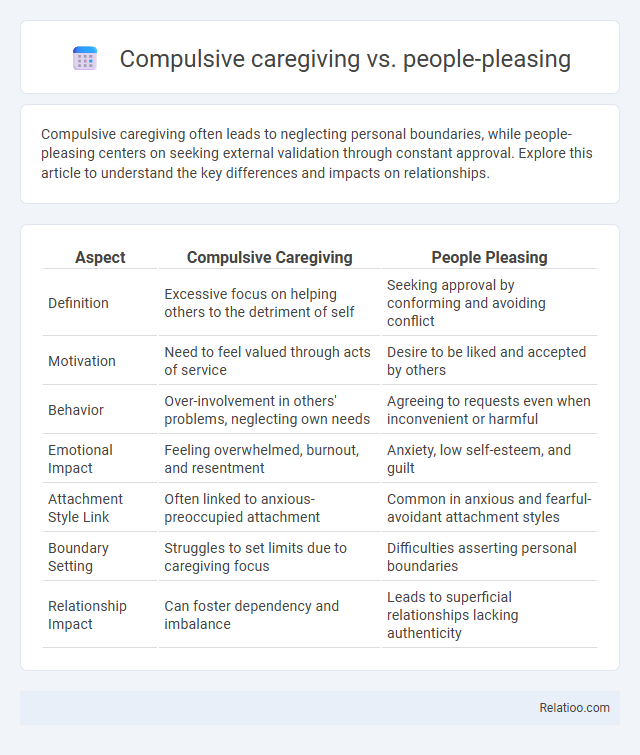Compulsive caregiving often leads to neglecting personal boundaries, while people-pleasing centers on seeking external validation through constant approval. Explore this article to understand the key differences and impacts on relationships.
Table of Comparison
| Aspect | Compulsive Caregiving | People Pleasing |
|---|---|---|
| Definition | Excessive focus on helping others to the detriment of self | Seeking approval by conforming and avoiding conflict |
| Motivation | Need to feel valued through acts of service | Desire to be liked and accepted by others |
| Behavior | Over-involvement in others' problems, neglecting own needs | Agreeing to requests even when inconvenient or harmful |
| Emotional Impact | Feeling overwhelmed, burnout, and resentment | Anxiety, low self-esteem, and guilt |
| Attachment Style Link | Often linked to anxious-preoccupied attachment | Common in anxious and fearful-avoidant attachment styles |
| Boundary Setting | Struggles to set limits due to caregiving focus | Difficulties asserting personal boundaries |
| Relationship Impact | Can foster dependency and imbalance | Leads to superficial relationships lacking authenticity |
Understanding Compulsive Caregiving
Compulsive caregiving involves an overwhelming urge to help others at the expense of your own well-being, often driven by deep-seated emotional needs or past trauma. Unlike people pleasing, which centers around gaining approval and avoiding conflict, compulsive caregiving is rooted in a compulsive need to fix or save others, frequently leading to burnout and blurred personal boundaries. Understanding compulsive caregiving helps you recognize these patterns, empowering you to establish healthier limits and prioritize self-care.
Defining People Pleasing Behavior
People pleasing behavior involves consistently prioritizing others' needs and approval over one's own well-being, often driven by a fear of rejection or conflict. Unlike compulsive caregiving, which centers on an uncontrollable urge to care for others, people pleasers seek external validation through compliance and agreeableness. Both behaviors can lead to emotional exhaustion and blurred personal boundaries, but people pleasing is primarily motivated by a deep desire for acceptance and avoidance of displeasure.
Core Differences Between Compulsive Caregiving and People Pleasing
Compulsive caregiving involves an overwhelming urge to take responsibility for others' well-being, often neglecting one's own needs, while people pleasing centers on the desire to gain approval and avoid conflict by accommodating others, sometimes at the expense of personal boundaries. The core difference lies in motivation: compulsive caregiving stems from a deep-seated need to nurture and fix others, whereas people pleasing is driven by fear of rejection and a need for acceptance. Understanding these distinctions is crucial for addressing underlying emotional patterns and developing healthier interpersonal dynamics.
Psychological Roots of Compulsive Caregiving
Compulsive caregiving often stems from deep psychological roots such as unmet childhood needs, fear of abandonment, and low self-worth, differentiating it from people pleasing, which primarily revolves around seeking approval and avoiding conflict. Unlike people pleasers who modify behavior mainly to gain acceptance, compulsive caregivers drive themselves to help excessively to feel valuable and maintain emotional connection, sometimes neglecting their own needs. Understanding these psychological origins is crucial for addressing the compulsive caregiving cycle and promoting healthier boundary-setting and self-care practices.
Underlying Causes of People Pleasing
People pleasing often stems from underlying causes such as low self-esteem, fear of rejection, and a strong desire for approval and acceptance. These individuals may prioritize others' needs to avoid conflict or gain validation, which differs from compulsive caregiving driven primarily by a deep-seated need to nurture or control. Understanding these psychological motivations helps distinguish people pleasing as a behavior rooted in insecurity rather than solely in caregiving tendencies.
Emotional Impact on Caregivers and Pleasers
Compulsive caregiving often leads to emotional exhaustion and resentment as caregivers sacrifice their own needs to meet others' demands, while people pleasing triggers anxiety and low self-esteem due to constant fear of rejection. Your emotional wellbeing may be compromised in both patterns because they revolve around seeking external validation at the expense of authentic self-expression. Understanding these dynamics is crucial to breaking the cycle and fostering healthier emotional boundaries.
Signs and Symptoms to Recognize
Compulsive caregiving often involves an excessive need to care for others at the expense of one's own well-being, marked by feelings of guilt when not helping and neglecting personal needs. People pleasing centers on a strong desire to gain approval and avoid conflict, characterized by saying "yes" despite personal discomfort and anxiety over others' judgments. Recognizing compulsive caregiving includes persistent overextension in support roles, while people pleasing is identified by chronic compliance and fear of rejection.
The Effects on Personal Boundaries
Compulsive caregiving often leads to blurred personal boundaries, as individuals prioritize others' needs over their own well-being, resulting in emotional exhaustion. People pleasing similarly undermines boundary-setting by driving a constant need for external validation and fear of rejection. Unlike compulsive caregiving, which centers on over-responsibility for others, people pleasing primarily manifests through seeking approval, both behaviors severely compromising healthy limits and self-care.
Strategies for Healing and Setting Boundaries
Healing from compulsive caregiving and people pleasing involves recognizing personal limits and cultivating self-awareness to prevent emotional exhaustion. Effective strategies include assertive communication, practicing saying no without guilt, and engaging in self-care routines to restore balance. Establishing clear boundaries through consistent reinforcement empowers individuals to honor their needs while maintaining healthy relationships.
Seeking Support and Professional Help
Compulsive caregiving often leads individuals to neglect seeking support or professional help, as they prioritize others' needs above their own mental health, unlike people pleasing where approval-seeking sometimes prompts external validation through support networks. People pleasing behaviors may encourage occasional reliance on others to gain approval, but compulsive caregiving creates an overwhelming sense of responsibility, hindering acknowledgment of personal distress. Recognizing these patterns, therapeutic interventions such as cognitive-behavioral therapy and support groups are crucial in helping individuals establish healthy boundaries and embrace professional assistance for sustainable well-being.

Infographic: Compulsive caregiving vs People pleasing
 relatioo.com
relatioo.com